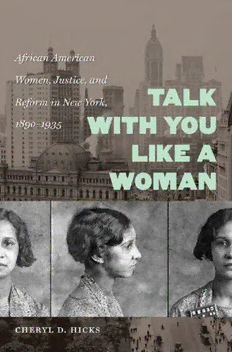
Talk with You Like a Woman: African American Women, Justice, and Reform in New York, 1890-1935 PDF
Preview Talk with You Like a Woman: African American Women, Justice, and Reform in New York, 1890-1935
talk with you like a woman GENDER AND AMERICAN CULTURE Coeditors Thadious M. Davis Mary Kelley Editorial Advisory Board Nancy Cott Jane Sherron De Hart John D’Emilio Farrah Griffin Amy Kaplan Linda K. Kerber Annette Kolodny Nell Irvin Painter Janice Radway Barbara Sicherman Emerita Board Members Cathy N. Davidson Sara Evans Wendy Martin A complete list of books published in Gender and American Culture is available at www.uncpress.unc.edu. talk with you like a woman AFRICAN AMERICAN WOMEN, JUSTICE, AND REFORM IN NEW YORK, 1890–1935 Cheryl D. Hicks The University of North Carolina Press(cid:1)Chapel Hill © 2010 THE UNIVERSITY OF NORTH CAROLINA PRESS All rights reserved Manufactured in the United States of America Designed by Kimberly Bryant and set in Miller and Smokler types by Tseng Information Systems, Inc. The paper in this book meets the guidelines for permanence and durability of the Committee on Production Guidelines for Book Longevity of the Council on Library Resources. The University of North Carolina Press has been a member of the Green Press Initiative since 2003. Library of Congress Cataloging-in-Publication Data Hicks, Cheryl D., 1971– Talk with you like a woman : African American women, justice, and reform in New York, 1890–1935 / Cheryl D. Hicks. p. cm. — (Gender and American culture) Includes bibliographical references and index. ISBN 978-0-8078-3424-4 (cloth : alk. paper) — ISBN 978-0-8078-7162-1 (pbk : alk. paper) 1. African American women—Employment—New York (State)—New York. 2. African American women—New York (State)—New York—Social conditions—History. 3. Sex role—New York (State)—New York—History—19th century. 4. Women’s rights—New York (State)—New York—History—19th century. 5. Racism—New York (State)—New York—History—20th century. I. Title. F128.9.N4H53 2010 305.48′8960730747—dc22 2010027107 cloth&14(cid:3)13(cid:3)12(cid:3)11(cid:3)10&5(cid:3)4(cid:3)3(cid:3)2(cid:3)1&&paper&14(cid:3)13(cid:3)12(cid:3)11(cid:3)10&5(cid:3)4(cid:3)3(cid:3)2(cid:3)1 Portions of this work appeared previously in somewhat different form in Cheryl D. Hicks, “‘In Danger of Becoming Morally Depraved’: Single Black Women, Working-Class Black Families, and New York State’s Wayward Minor Law, 1917–1928,” University of Pennsylvania Law Review 151 U. PA. L. Rev. 2077 (2003) (printed here with permission); and Cheryl D. Hicks, “‘Bright and Good Looking Colored Girl’: Black Women’s Sexuality and ‘Harmful Intimacy’ in Early Twentieth- Century New York,” Journal of the History of Sexuality 18, no. 3 (2009): 418–56 (© 2009 by the University of Texas Press. All rights reserved). for my parents, THEODORE W. HICKS and DELORIS J. HICKS and my sister, MICHELLE R. HICKS contents Acknowledgments xi INTRODUCTION Talk with You Like a Woman 1 I African American Urban Life and the Multiple Meanings of Protection in the City CHAPTER 1 To Live a Fuller and Freer Life Black Women Migrants’ Expectations and New York’s Urban Realities, 1890–1927 23 CHAPTER 2 The Only One That Would Be Interested in Me Police Brutality, Black Women’s Protection, and the New York Race Riot of 1900 53 CHAPTER 3 I Want to Save These Girls Single Black Women and Their Protectors, 1895–1911 91 II Urban Reform and Criminal Justice CHAPTER 4 Colored Women of Hard and Vicious Character Respectability, Domesticity, and Crime, 1893–1933 125 CHAPTER 5 Tragedy of the Colored Girl in Court The National Urban League and New York’s Women’s Court, 1911–1931 159 CHAPTER 6 In Danger of Becoming Morally Depraved Single Black Women, Working-Class Black Families, and New York State’s Wayward Minor Laws, 1917–1928 182 CHAPTER 7 A Rather Bright and Good-Looking Colored Girl Black Women’s Sexuality, “Harmful Intimacy,” and Attempts to Regulate Desire, 1917–1928 204 III Rehabilitation, Respectability, and Race CHAPTER 8 I Don’t Live on My Sister, I Living of Myself Parole, Gender, and Black Families, 1905–1935 237 CHAPTER 9 She Would Be Better off in the South Sending Women on Parole to Their Southern Kin, 1920–1935 253 CONCLUSION Thank God I Am Independent One More Time 271 Notes 279&Bibliography 335&Index 355 This page intentionally left blank illustrations Sketch of Lavinia Johnson’s beating 76 Sketch of the attempted lynching of Alexander Robinson 80 Victoria Earle Matthews 97 Victoria Matthews and helpers at the White Rose Mission 103 Children of the White Rose Mission 104 Frances Kellor 112 “The Problem of the Young Negro Girl from the South” 115 Odessa Crouch 144 Annie Howard 145 Giselle Hopkins 147 Evelyn Pitts 153 Grace P. Campbell 162 Bedford’s interracial nursery 198 Carrie Hall 265
